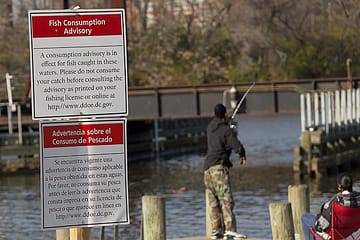Pamela WoodContact ReporterThe Baltimore Sun
For decades, visitors to Fort Howard Park in southeastern Baltimore County have admired — and to some extent abused — a pair of historic cannons.
The cannons have been climbed on like a jungle gym, used as trash receptacles and even had names carved on their barrels.
Now, thanks to the work of community residents and a retired Maryland Army National Guard staff sergeant, the cannons —M1906 field artillery guns — are getting a makeover at the guard maintenance facility in Havre de Grace, where service members are working to restore them to their World War I-era glory.
Officials in Baltimore County, which operates Fort Howard Park, acknowledge the nearly 100-year-old cannons are the victims of “benign neglect,” suffering from a lack of maintenance and in general state of disrepair.
“They were just put there and they wasted away,” said Kathy Labuda, secretary of the Fort Howard Community Association, a group that formed early this year.
The association put the cannons high on its list of issues to address but initially didn’t have much luck. Emails to officials in the Army — which technically still owns the cannons — were never returned.
Things got moving, though, when residents found a community partner they didn’t know existed: Les Ernest, a recently retired staff sergeant and 31-year veteran of the Guard.
Ernest, an Essex resident, said he was on a walk one day at Fort Howard when he saw the cannons and was taken aback by their condition.
“It bothered me they were in disarray,” he said.
Ernest contacted the Dundalk-Patapsco Neck Historical Society, which in turn told him of the Fort Howard Community Association’s interest in restoring the cannons.
A few phone calls and emails later, the parties were shaping restoration plans, forming a partnership with the historical society, the local recreation council, county government and others.
“It just worked out very well,” said historical society board member Rose Benton.
Until Ernest got involved, Labuda said, it never occurred to neighborhood leaders that the National Guard might be able to help.
For Ernest, it was a no-brainer.
“We’ve done several restoration projects, but nothing this old,” Ernest said of the maintenance shop staff. “I was like, ‘This would be a great project for our guys in Havre de Grace besides working on green trucks.'”
Soldiers have found a few surprises since they began work on the cannons in November.
For one, the guns were never properly demilitarized — the barrels were never capped, and trash found inside included old soda cans and a deteriorated baseball.
Also, the cannons’ firing pins were still in place and the cranks to aim the barrels were still operational — though rusted in place.
“The appearance is terrible-looking, but when we pulled the wheels off, it had the original grease,” Ernest said. “They’re pretty much complete.”
“The only thing stopping it now is the rust,” said Warrant Officer Steve Norris, inspection and supply production control supervisor.
The cannons weren’t actually used at Fort Howard, which is at the tip of the North Point Peninsula and which served as a military base from 1896 to 1940.
At that time, the fort was turned over to the Department of Veterans Affairs to become a hospital. The VA gave some of the land to Baltimore County to create a park in the 1970s, and the cannons were brought in as a decorative feature.
The cannons, built in 1918, are among only about five dozen of their type that were made. Some M1906 guns were sent to war in France, though it’s not believed that the cannons donated to Fort Howard ever saw wartime action.
From end to end, the weapons are about 20 feet long and stand more than 5 feet. Each weighs 4 tons.
The guns would have been manned by a team of three to six soldiers, including one to load 3-foot-long rounds into the barrel, another soldier to aim and another soldier to fire it.
At the Havre de Grace shop, the cannons sit in a bay in the middle of the building, flanked by a black SUV and three large Army trucks that are also in for repairs.
Those vehicles take priority over the historic cannons, Norris said, though the soldiers in the shop enjoy the opportunity to work on something with a bit more history.
On a recent morning, Staff Sgt. Kenneth Musselman leaned over the breech door of one of the cannons — where the round would have been inserted — and attacked it alternately with a cordless drill, a long screwdriver and a heavy mallet.
The Havre de Grace crew had already removed the firing pin from one cannon and Musselman was working to free the pin from the other.
While today’s large field guns — such as the Howitzer M777 — are more technologically advanced, restoring the Fort Howard cannons is a good opportunity to practice welding, stripping, painting and mechanical repair skills, Norris said.
“It’s helping our guys out,” he said. “Getting something like this helps us keep sharp.”
The National Guard is absorbing the cost of labor to restore the cannons, but officials said they can’t estimate the overall cost. The community association is providing supplies, such as paint.
While the guns themselves are getting a makeover in Havre de Grace, the original wooden wheels that supported them are being restored by Chesapeake Woodworking in Baltimore, which has discounted its rate for the project.
The Fort Howard Community Association hopes to raise $15,000 to $20,000 to pay for the restoration supplies and the repairs to the wheels.
Once restored, the cannons will be remounted on the wheels and placed on new supports. The National Guard will install signs describing the cannons’ significance, and the community association hopes to add landscaping and possibly a small fence to discourage people from climbing on them.
Baltimore County has offered to pour concrete slabs for the cannons, said Barry F. Williams, director of the Department of Recreation and Parks.
Williams said he’s often thought about getting the cannons restored, but with so many priorities at 200-plus county parks, it never happened until the Fort Howard volunteers and the National Guard presented a plan.
Williams said he’s glad they’re being rescued, in large part due to community efforts.
“I’m very pleased to say people are very actively taking an interest in that park, and they want things to be nice,” he said.
If all goes according to plan, the cannons and the wheels will be ready to be reinstalled in the spring.
Scott Pappas, vice president of the Fort Howard association, said a ceremony will rededicate the cannons in honor of veterans. He described Fort Howard as a patriotic and veteran-loving neighborhood that counts its Memorial Day ceremony as its biggest celebration of the year.
“These cannons are a symbol of our veterans’ sacrifices,” he said.


